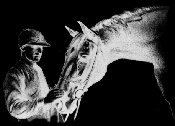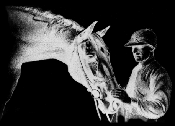Liniments are probably the most well known of all the veterinary preparations used by the everyday Horseman. Almost every barn of the past that housed a working horse would have a bottle of liniment or
embrocation, as it was sometimes known, sitting some where in its recesses. Liniments have been so secretly formulated, patented, and gleefully marketed through the ages that these mystical solutions are almost a laughing stock in today's veterinary/medical circles. You will be hard put to find a veterinarian that will freely prescribe a liniment treatment on his own. This is not to say that liniments are without value. Contraire. Our finely latexed friends from the ivy towers of equine medicine are far from authorities on race horse physical therapy. I would like to have a dime for every horse they have labeled as unraceable and gone on to win races. Personally, I remember growing up in the 1960's, working out of my granddaddy's barn with accouterments of
Absorbine,
Gombalt's Caustic Balsam , Tuttle's Elixir, and a few other patent medicines sitting on a shelf ready for any infirmity. They were a permanent fixture of a barn in my young eyes, never to be questioned or doubted. Perhaps that is the problem, they have always been present in the traditions of horse husbandry, but few people understand their pharmacologic merits and uses. So when should a liniment be used and what type?
A liniment by nature has always been applied with a groom's rubbing hands over some ailing body part of the horse. This combination of massaging hands wetted with the liniment provides the physiologic healing mechanism, so respected through the ages. It seems in the history of embrocations, they were most always of a counterirritant nature. Characteristically, liniments were formulated with a soap and/or oil base aiding in the lubrication of the hands and fingers during massage.
Liniment and stable bandages may or may not be combined. If you are applying a liniment after working a sound horse, then bandages are not called for. One may apply a liniment as a general stimulating, relaxing agent accompanied by light massage as it is being worked into the legs or body region. A counterirritant type of liniment would be the most desirable in this situation where no apparent soreness is present or being treated. On the other hand, if you have reason to suspect a problem after work or you are treating an on going problem, bandages should probably be put on the horse over the liniment. This allows the liniment to be directed in toward the leg and guards against rapid evaporation from the hide's surface. Also, bandages will provide protection and retard edema (swelling/filling) in this more serious situation.
Liniments are routinely used on race horses only very casually as a preventive or for the first recognition of a suspicious leg. If I had a horse galloping and training nicely with no visible leg problems, doing him up with a liniment would allow me to perform a closer, hands-on, inspection. By massaging his legs, tendons and ligaments while working the liniment in, allows me to assess the integrity of each structure which might have been missed otherwise. If your horse is stocking up (generalized leg edema) overnight, then bandages with a liniment is also indicated when putting the horse away after morning work. A counterirritant type of liniment will help stimulate blood/lymphatic flow and relieve any possible transient soreness.
If an acute, more serious injury seems to be manifesting itself in your horse's leg then something a bit stronger may be in order, i.e. a leg paint, poultice, or sweat. Such common leg injuries calling for more than a liniment would include superficial/deep flexor tendon sore spots, suspensory ligament sore spots, check ligament soreness, any type of bone damage or growth, joint capsule distensions, tendon sheath distensions, and any non-broken skin injury due to gait interference. All of these unsoundnesses may or may not be accompanied by actual lameness on the part of the horse, but all are a step beyond what a common liniment was designed for.
Common generic veterinary liniments of the past have included Liniment of Aconite, Camphor Liniment, Liniment of Croton Oil, or variations. Many had an oil or soap component. One way to achieve a soap/oil base is to mix 500 cc of a lime solution with 500 cc of olive oil. The reaction will produce a thick creamy mixture after it is shaken, of soap and oil. A good way to infuse various desired herbs into this formula is to first extract the herbs into the olive oil and filter. Once filtered, add the same amount by volume of a lime solution to your herb infused olive oil. Lime is Calcium oxide, processed from marble. Perhaps an easier method is to just add soap to your herbal alcohol solution. Soft soap or green soap is what is needed. Soft soap is made from olive oil and potassium hydroxide. Soft soap by itself has active medicinal properties of a topical nature. It removes fats from the skin surface which is sometimes beneficial. There are also softening benefits to the skin, aiding in the removal of crusts and skin scales.
Here is an example of an herbal liniment which anyone can make. Herbs can generally be substituted according to your specific needs and plant availability. This is a specially formulated counter-irritant liniment I did myself. It is made from black mustard, camphor, rubbing alcohol, olive oil, and lime. If you prefer the recipe to be less complicated just add soap directly and delete the olive oil and lime solution.
















